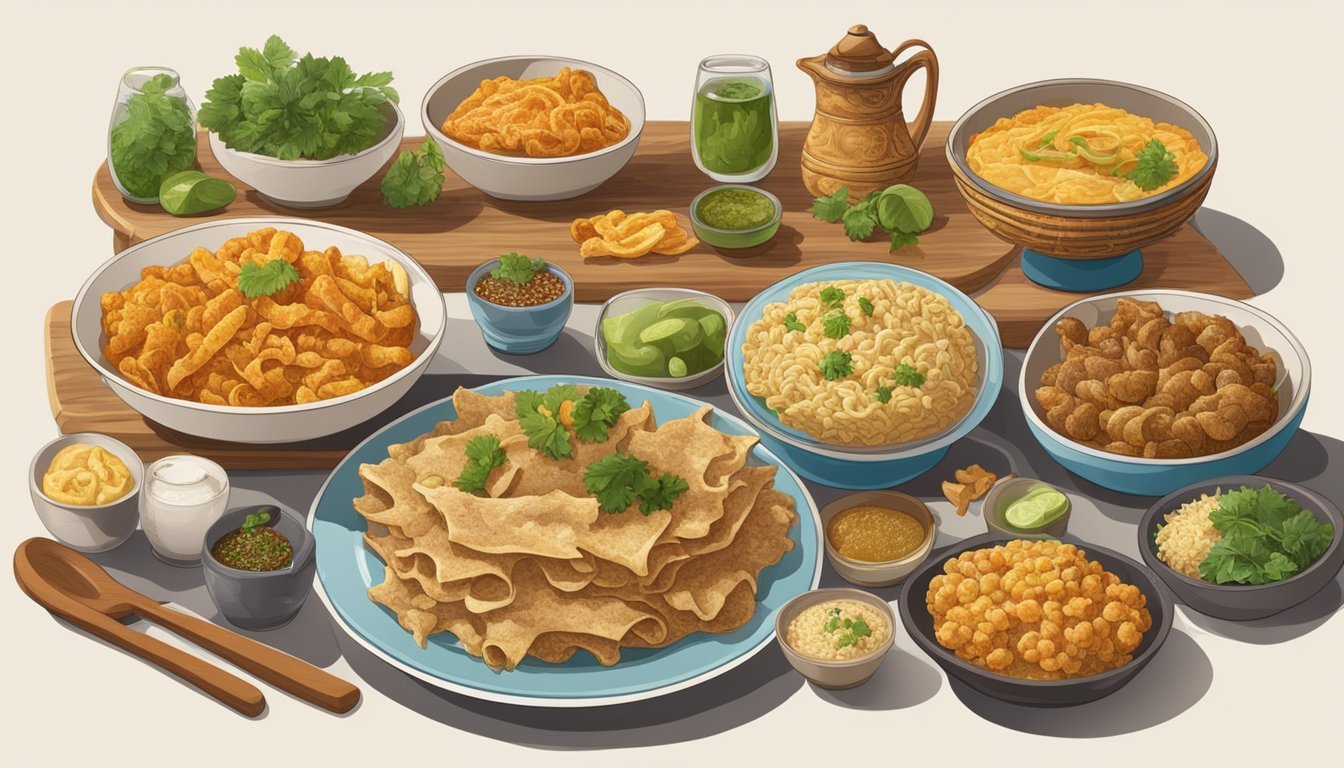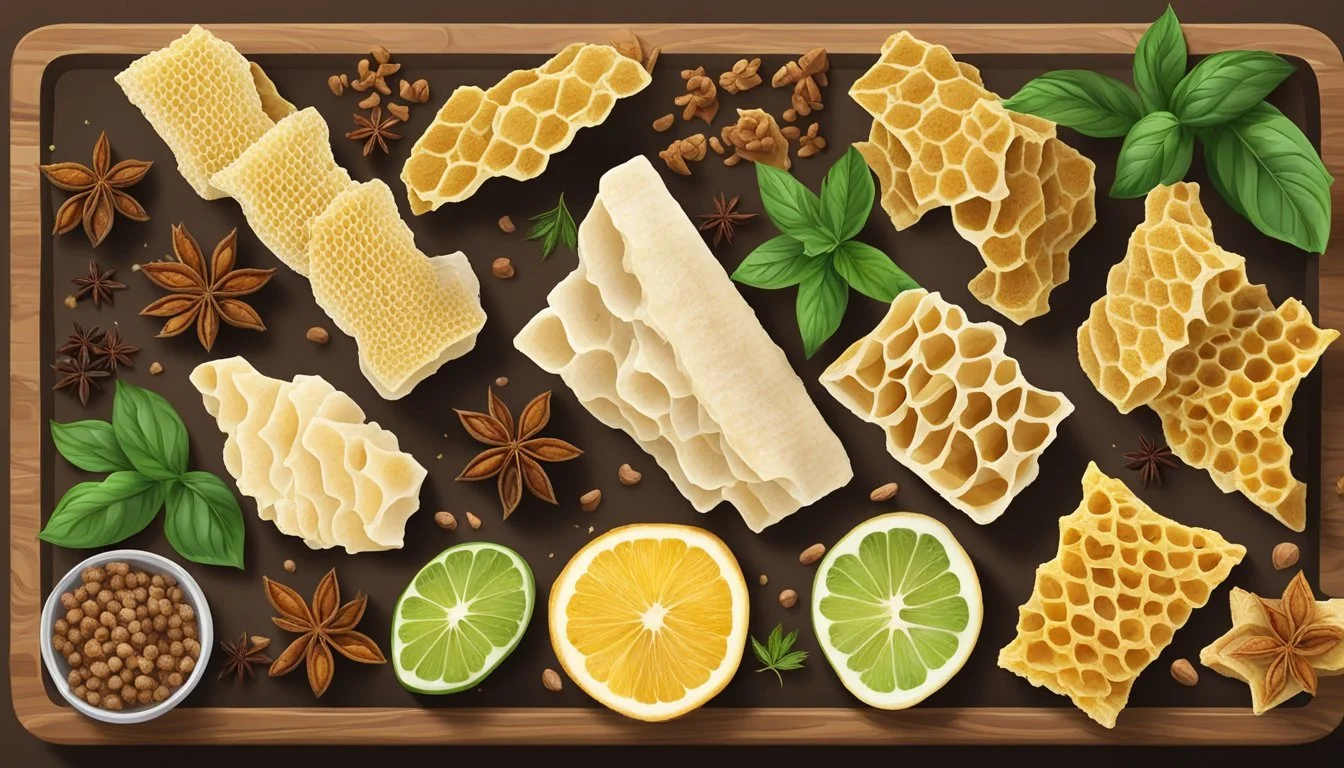Tripe
Unveiling the Global Culinary Staple of Stomach Lining
Tripe, the edible stomach lining of ruminant animals such as cows, sheep, and goats, is a culinary ingredient with a rich historical presence across various cultures. Despite its humble origins, tripe has established itself as a versatile and nutritious component of numerous traditional dishes. It's appreciated for its distinctive texture and ability to absorb the hearty flavors of the foods with which it's cooked.
In global cuisines, from the spicy Sichuan hotpot of China to the savory menudo of Mexico, tripe has been embraced for centuries. The preparation methods of tripe are as diverse as the cultures that utilize it. Some regions prefer it well-cooked to a tender consistency, sometimes accompanied by vegetables, legumes, or bread, while others may serve it in more robust stews (What wine goes well with stews?) or soups that highlight its unique chewiness.
Nutritionally, tripe offers a range of benefits as it is low in calories and dietary cholesterol. While some may be skeptical of its texture or origin, those familiar with tripe value it for its protein content and the essential nutrients it provides. Thus, tripe remains an integral part of many diets around the world, maintaining its position as a staple food item in a myriad of traditional culinary contexts.
The Basics of Tripe
Tripe is the edible stomach lining from ruminant animals such as cattle, sheep, and goats, valued in various cuisines around the globe.
Defining Tripe and Its Origins
Tripe is specifically the lining of the stomach from ruminant animals. These animals, including cattle, sheep, and goats, have complex stomach systems with multiple chambers. Historically, tripe has been a fundamental element in the diets of many cultures due to its nutritional value and availability. It has provided a source of protein for communities that valued whole-animal consumption.
Tripe in Culinary Traditions
Across world cuisines, tripe is prepared in a multitude of ways, reflecting the diverse culinary traditions and techniques of various cultures. In Italy, tripe is served in dishes like Trippa alla Romana. In Asia, it's often incorporated into soups and stews, such as the popular Korean dish, Gopchang-jeongol. The ingredient's versatility allows it to take on the flavors of rich sauces and seasonings, making it a cherished food in many countries. French cuisine also features tripe in the form of andouillette, a type of sausage.
In these recipes, the stomach lining is typically cleaned, boiled until tender, then either slow-cooked or fried with various seasonings, vegetables, and sauces. This ingredient's unique texture and ability to absorb flavors make it a distinctive component in these traditional dishes.
Nutritional Profile of Tripe
Tripe, the stomach lining of ruminant animals, is recognized for its rich provision of essential nutrients. Its consumption offers a blend of proteins, vitamins, and minerals, beneficial for various bodily functions.
Macro and Micro-Nutrients
Protein: Tripe is a significant source of lean protein, essential for muscle repair and growth. A typical 3-ounce serving contains a substantial amount of this macronutrient, which is crucial for maintaining muscle mass and overall bodily functions.
Fat: The fat content in tripe is relatively low, making it a choice for those monitoring their fat intake. In 150 grams of tripe, there is approximately 5.5 grams of fat, which contributes to its status as a lean meat option.
Vitamins and Minerals: Tripe is packed with an array of vitamins and minerals. Notably, it provides an excellent source of vitamin B12, necessary for blood formation and brain health. Zinc, present in tripe, supports the immune system, and selenium contributes to thyroid function and antioxidant defense. Additionally, tripe offers other nutrients like iron, which is vital for carrying oxygen in the blood, calcium for bones, magnesium that aids over 300 enzyme reactions, phosphorus for cell repair, and potassium that helps regulate heart rate and blood pressure.
Protein:Approx. 14 grams per 100 grams of cooked tripe
Vitamin B12: Substantial percentage of Recommended Daily Intake (RDI)
Selenium: Significant amount per 100 grams of cooked tripe
Zinc: Considerable percentage of Recommended Daily Intake (RDI)
Health Benefits and Considerations
Tripe is associated with several health benefits due to its rich nutritional composition. The protein content aids in satiety and may support weight management. Being low in calories, with only about 94 calories per 100-gram serving, tripe can be a suitable part of a calorie-conscience diet. The vitamins and minerals in tripe are valuable for overall health maintenance, particularly for individuals with dietary deficiencies.
However, individuals should consider the cholesterol content in tripe, as some servings can contain moderate amounts of dietary cholesterol. It is essential for those with cholesterol-related health concerns to consume tripe in moderation and balance it with a diet rich in fiber and other cholesterol-lowering foods. Additionally, the preparation method of tripe can significantly affect its nutritional benefits—if cooked with high-fat ingredients or methods, it may counteract its naturally low-fat advantage.
Types of Tripe and Textural Qualities
Tripe, the stomach lining from various ruminant animals, comes in several types, each with distinct textural characteristics that influence its culinary uses.
Different Types of Tripe from Around the World
Tripe is traditionally categorized based on which one of the first three chambers of a ruminant’s stomach it originates from:
Beef Tripe: Often considered the standard, it comes from cows and is divided into several types:
Honeycomb Tripe: Derived from the second chamber, the reticulum, honeycomb tripe is named for its unique pattern and is prized for its tender texture and ability to absorb flavors.
Blanket Tripe or Flat Tripe: Sourced from the first stomach chamber, the rumen, this type has a thicker and flatter appearance.
Book Tripe: Also known as bible tripe, it comes from the omasum and is characterized by its leaf-like layers.
Other Varieties: Tripe from other ruminants like sheep and goats is also consumed worldwide, though less common than beef tripe.
Examining Texture and Taste
The textural and flavor profiles of tripe vary widely, influencing its application in different culinary traditions:
Texture:
Honeycomb Tripe: Recognized for its chewy yet tender texture and its honeycomb pattern, which not only adds visual appeal but also helps it hold onto sauces.
Blanket and Book Tripe: Generally have a thicker consistency with more chew due to a higher concentration of connective tissue.
Taste:
Tripe typically has a mild flavor, which makes it versatile for various seasoning approaches. It often takes on the taste of the ingredients it is cooked with, especially when part of soupy or saucy dishes.
The color of the tripe, which can range from pale to deep colors, is also indicative of the way it was processed and prepared, but it does not significantly affect the taste.
Through these distinctions, each type of tripe contributes uniquely to world cuisines, offering chefs and home cooks a versatile ingredient with various textural possibilities.
Culinary Techniques and Preparation
When it comes to tripe, meticulous cleaning and specific cooking methods are paramount for creating palatable dishes that showcase its unique texture and flavor.
Cleaning and Preparing Tripe
Before cooking, tripe requires thorough cleaning to ensure that it is free from impurities. The process often starts by rinsing the tripe under cold water to remove any residual blood or grit. It should then be soaked in a mixture of cold water and vinegar or a mild bleaching solution to aid in further purification. After cleaning, excess fat and any tough membranes should be trimmed away with a sharp knife. The tripe can then be cut into uniform pieces -- commonly bite-sized -- making them suitable for various recipes.
Cooking Methods for Palatable Dishes
The cooking process for tripe is crucial in making it tender and flavor-packed. This often involves a long, slow simmering that can last several hours:
Boiling: Tripe is typically covered in water and brought to a boil. The water is then reduced to a gentle simmer until the tripe is tender.
Soups and Stews: It's common to include tripe in rich stews and soups, where it can absorb the flavors of herbs, vegetables, and seasonings. Key ingredients such as garlic, onions, salt, and pepper provide a robust foundation for these dishes. Additionally, tripe has the ability to infuse its distinctive taste into the cooking liquid, enhancing the overall dish.
Seasoning and Spices: Once tender, tripe usually benefits from a variety of spices and spices combinations, such as Italian herbs in a tomato sauce or Asian spices in a pho broth.
Example Recipes:
Soup:
Ingredients: tripe, onions, garlic, salt, pepper, herbs, and vegetable broth.
Preparation: Clean and boil the tripe; add to a seasoned broth with vegetables.
Stew:
Ingredients: tripe, tomato sauce, onions, garlic, salt, pepper, and mixed vegetables.
Preparation: Boil the tripe until tender; simmer with sauce and vegetables until flavors meld.
Tripe in Global Dishes
Tripe serves as an essential ingredient in various traditional dishes around the world, each embracing its unique texture and ability to absorb flavors.
Tripe Across Various Cuisines
Italy: In Italy, tripe is celebrated in dishes like trippa alla romana, where it is stewed with tomatoes and herbs, and served with Parmesan cheese, highlighting its ability to complement rich, herbaceous flavors.
Asian Cuisine: Asian preparations often incorporate tripe into soups and stir-fries. In Chinese cuisine, for example, it is a key ingredient in the Sichuan dish fuqi feipian, known for its bold spices. Pho, a Vietnamese noodle soup, sometimes includes tripe, valuing its texture and taste profile.
Latin America: A notable dish in Latin American cuisine is menudo, a hearty Mexican tripe soup reputed for its complex flavor and purported hangover-curing properties. In Puerto Rico, cuajito features stewed tripe served with boiled plantains, revealing the ingredient's versatility.
Caribbean: The Caribbean culinary scene also makes use of tripe, often pairing it with spices, vegetables, and plantains, emphasizing the region's preference for robust, well-seasoned dishes.
Signature Tripe Recipes
Menudo: A traditional Mexican stew made of tripe, chili peppers, lime, cilantro, and hominy. Its deep flavor and satisfying texture make it a staple during festivities.
Mondongo: Common throughout the Caribbean and Latin America, this tripe stew is enriched with a variety of vegetables and aromatic spices, illustrating how tripe acts as a canvas for a region's signature flavors.
Tripe Soup: From the hearty menudo to the lighter but equally flavorful Italian brodo di trippa, tripe soup varies from region to region, each with its unique assortment of spices and accompanying ingredients, displaying the universal appeal of this humble offal.
Tripe Beyond Human Consumption
Though tripe is well known as a nutritious organ meat in various human cuisines, its role extends into non-human applications, most notably in pet food and a few other less common areas.
Tripe in Pet Food
Tripe, particularly green tripe, is a popular ingredient in pet food due to its nutritional content, which includes essential enzymes, gastric juices, and amino acids beneficial for an animal's health. Green tripe refers to the unprocessed or lightly processed stomach lining, which retains more of its nutritional benefits compared to more processed forms. Pet food manufacturers often incorporate tripe for its:
High protein content
Digestive enzymes that aid pet digestion
Natural balance of minerals and nutrients
It's important to differentiate that the tripe in pet food should be appropriately cleaned and processed to ensure it's safe for animal consumption.
Other Lesser-Known Uses
In addition to its role in pet nutrition, tripe has been used in various other less-visible applications:
Agriculture: It is occasionally used in farm settings as a high-protein feed component.
Fashion: Some offal products, including tripe, have historically been used in the production of certain leathers and textiles.
These uses of tripe further demonstrate the organ's versatility and importance beyond just a food source for human consumption.
Sourcing and Sustainability
In the context of sourcing and sustainability, tripe presents opportunities for both culinary exploration and environmental consciousness. This section will explore how to procure high-quality tripe and its place in sustainable eating practices.
Where to Find and Select Quality Tripe
Shoppers can typically find tripe in various locales, ranging from local butchers to supermarkets. Specialty butchers often provide the freshest options, which can be beneficial for both taste and nutritional value. When selecting tripe, individuals should look for pale, off-white coloration with a clean smell, indicative of proper handling and freshness.
Quality indicators:
Pale, off-white color
Absence of strong odors
Firm texture upon touch
The Role of Tripe in Sustainable Eating
Tripe can play a significant role in sustainable eating due to the use of farm animal byproducts that might otherwise go to waste. As part of the "nose-to-tail" eating philosophy, not only the muscle meat but also organs like tripe, along with ear and heart, are utilized. This holistic approach to consumption ensures minimal waste and maximizes the use of the animals raised for food.
"Nose-to-Tail" Philosophy:
Sustainable: Reduces waste by using more parts of farm animals
Nutritious: Tripe is rich in nutrients like vitamin B12 and zinc
Tradition: Honors a longstanding practice in many cultures of respecting the animal by using as much of it as possible
Cultural Significance and Beliefs
Tripe holds distinct positions in various cultures, often linked to ceremonial practices and societal status. This offal is not just food, but a vessel carrying historical and symbolic weight.
Tripe in Cultural Ceremonies and Traditions
In many societies, tripe is more than a culinary preference; it's a bridge to the past, linking generations through traditional dishes. Italy has long upheld tripe as a staple, incorporating it into their celebratory fare like trippa alla romana, especially during festivals and communal gatherings. Similarly, in parts of Asia, specifically China, tripe is routinely prepared during the Lunar New Year, signifying abundance and prosperity. The way it's cooked and served varies, but the underlying theme remains: tripe binds communities through shared culinary heritage.
Symbolism and Status Across Societies
The consumption of tripe carries varying symbols of status across different cultures. In some African societies, for instance, specific parts of the tripe are reserved for elders or guests of honor, indicative of respect and high esteem. Conversely, in historical European contexts, it was sometimes considered a less desirable meat, often associated with the working class. However, this perception has shifted over time, with tripe now celebrated as a gourmet ingredient by chefs and food enthusiasts internationally, transcending its humble beginnings to achieve a form of cultural reclamation.
Tripe in Modern Fusion Cuisine
In the realm of modern fusion cuisine, tripe has been embraced by chefs who are eager to blend traditional elements with contemporary tastes. They incorporate this ingredient into an array of innovative dishes, from reinterpretations of classic fare to entirely novel creations.
The sturdy texture of tripe lends itself to bold flavors and spices, making it a popular choice for inventive taco fillings or as an unexpected twist in a hearty stew. Chefs often pair it with ingredients that have contrasting textures, such as crisp vegetables or creamy sauces, to create dishes that are as much about the experience as they are about the taste.
Here's a glimpse into the versatile role of tripe in fusion dishes:
Tacos: Honeycomb tripe combined with a smoky chipotle salsa and topped with fresh cilantro.
Pasta: Tripe incorporated into a rich tomato-based ragù served over al dente noodles.
Pizza: Sliced tripe on a wood-fired pizza with caramelized onions and artisanal cheeses.
Sandwiches: Marinated tripe in a banh mi with pickled vegetables (What wine goes well with pickled vegetables?) and a spicy mayo.
This exploration into the inventive use of tripe reflects chefs' commitment to sustainability, using all parts of an animal, and the curiosity of diners seeking new and exciting flavors. The adaptability of tripe ensures that it continues to be a staple ingredient, offering a unique texture and potent flavor that complements and elevates fusion menus.
Conclusion
Tripe, the edible stomach lining of ruminant animals such as cows, sheep, and pigs, has proven itself to be a versatile and culturally significant food. Across the globe, it plays a vital role in traditional dishes, from the rich and savory Menudo in Mexico to the comforting Pho in Vietnam.
In terms of nutrition, tripe is a source of protein and several important micronutrients, making it a nutritionally beneficial component of a meal. While its chewy texture might be novel to some, it is exactly this characteristic that adds a unique experience to culinary exploration.
For those interested in culinary diversity, tripe offers an avenue to explore the food traditions of varied cultures. Chefs often appreciate tripe for its ability to absorb the flavors of the ingredients it is cooked with, allowing for a wide range of seasoning possibilities.
Experts have noted that tripe's presence in global cuisines is unlikely to diminish due to its embedded place in culinary traditions and the ongoing exploration of traditional dishes by modern food enthusiasts. Hence, tripe remains a testament to the ingenuity of traditional cooking methods and the universal human experience of turning all parts of an animal into nourishing meals.
In conclusion, the endurance of tripe in culinary practices around the world showcases humanity's resourcefulness and its continuous quest for sustenance and flavor.








